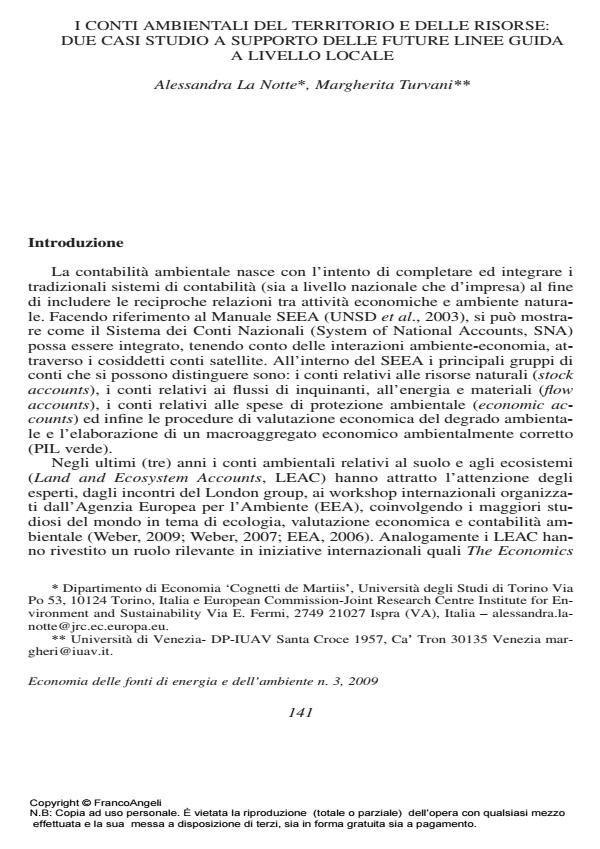I conti ambientali del territorio e delle risorse: due casi studio a supporto delle future linee guida a livello locale
Journal title ECONOMIA DELLE FONTI DI ENERGIA E DELL’AMBIENTE
Author/s Alessandra La Notte, Margherita Turvani
Publishing Year 2010 Issue 2009/3
Language Italian Pages 24 P. 141-164 File size 2135 KB
DOI 10.3280/EFE2009-003007
DOI is like a bar code for intellectual property: to have more infomation
click here
Below, you can see the article first page
If you want to buy this article in PDF format, you can do it, following the instructions to buy download credits

FrancoAngeli is member of Publishers International Linking Association, Inc (PILA), a not-for-profit association which run the CrossRef service enabling links to and from online scholarly content.
Environmental accounts for resources and territory at local scale: two case studies testing possible future guidelines - Asset accounts are one of the main groups of environmental account modules. They refer to natural resources and ecosystems. On the one hand natural resource accounts are well developed and they are going to be soon standardized. On the other hand the EEA is still developing ecosystem accounts. As it happens for natural resource accounts, the question arises on how to apply the complex framework of ecosystem accounts at different scales: from the global to the national to the local. Different users will have different purposes to serve: the simplified accounts will help addressing some global issues, while there will be a rigorous framework for ecosystem accounts at national level and probably some guidelines will be applied to the (necessarily) flexible local contexts. The two case studies presented in this article attempt to propose a general procedure to build a balance for the territory: both economic and non economic (ecosystem) functions are valued adopting the theoretical base underlying the Total Economic Value and the accounting framework proposed by the IEEAF. In the first case study the opening stock of Cansiglio forest is assessed by quantifying in physical and monetary terms: the productive, protective, recreational functions together with the carbon stock and biodiversity. The same functions are valued for the second case study, the St.Erasmo island within the Lagoon of Venice, by using different methods and different reference units. In both applications the used georeferenced databases highly contribute to the final valuation. There are some important results to highlight when considering the weights of each function in the TEV. Although the feasibility of applying this procedure, there are some critical issues that need to be discussed. The first issue is related to the classification of ecosystems services/functions: recently some international workshop took place in order to harmonize the environmental accounting classification reported in the SEEA2003 with the most important classifications currently debated on the international arena (e.g. MEA and TEEB). The case studies proved to be useful not only for the results they provide but also for the critical questions they raised in order to better address the future research in this issues.
Keywords: Environmental accounting, asset accounts, valuation, TEV, spatial assessment
Jel codes: Q23, Q24, Q51, Q56, Q57
Alessandra La Notte, Margherita Turvani, I conti ambientali del territorio e delle risorse: due casi studio a supporto delle future linee guida a livello locale in "ECONOMIA DELLE FONTI DI ENERGIA E DELL’AMBIENTE" 3/2009, pp 141-164, DOI: 10.3280/EFE2009-003007